Water Quality in Coal Creek Following the 2021 Marshall Fire
Publication Date: 2023
Abstract
The Marshall Fire was the largest of multiple fires that spread through Boulder County on December 30, 2021, destroying over 1,000 structures and raising concerns regarding the water quality and ecosystem health of Coal Creek. This stream and wetland habitat play a crucial role in supporting sensitive species and are important for recreation and agriculture within the affected region. This study was designed to monitor the impacts of the fire on water quality at the wildland-urban interface (WUI), where constituents (some of which may be contaminants) can enter the stream from both wildland and urban sources. Water samples were collected from multiple sites that had been selected with the goal of comparing between burned and unburned, and urban and non-urban areas. However, each sampling location has runoff that originates from a range of landscapes (i.e., burned vs. unburned, urban vs. non-urban) making data interpretation nuanced. Analysis of the samples revealed elevated levels of dissolved organic carbon, nutrients, sediment, and trace metals at burn-impacted sites in urban areas during the first snow events after the fire compared to sites with more runoff contributions from unburned areas. These burn-impacted urban sites had the highest levels of potentially toxic metals including zinc and aluminum, indicating that the Marshall Fire may have introduced these anthropogenic materials into Coal Creek. Toxicity depends on concentration and exposure duration. During later season sampling events, runoff from burned urban areas had copper, aluminum, and zinc levels that exceeded aquatic life standards, posing a potential threat to the wetland habitat and impact to recreation activities and agricultural uses that depend on healthy ecosystems. Although higher concentrations of metals were observed at sites within the burned, urban area, it is not possible to categorically attribute effects to the fire without long-term monitoring data. The results of this study highlight a need to better understand the role of WUI fires on water quality due to the policy implications for stormwater management.
Introduction

The Marshall Fire, which was the largest of several fires that spread through Boulder County on December 30, 2021, set a record for the most property destroyed in a Colorado wildfire, with over 1,000 structures lost in the Town of Superior, City of Louisville, and unincorporated Boulder County. As shown in Figure 1, the fire also burned a significant portion of the Coal Creek watershed, which is a vital waterway for both recreational and agricultural use in Boulder County. Consisting of wetlands adjacent to the creek, the riparian zone supports a range of ecologically necessary and sensitive species. For example, the northern leopard frog which is found in the riparian corridor of upper Coal Creek in Boulder County, is classified as a tier 1 species of greatest conservation need in the state of Colorado.
Figure 1. Map of the Marshall Fire Burn Perimeter Relative to the Coal Creek Drainage Area
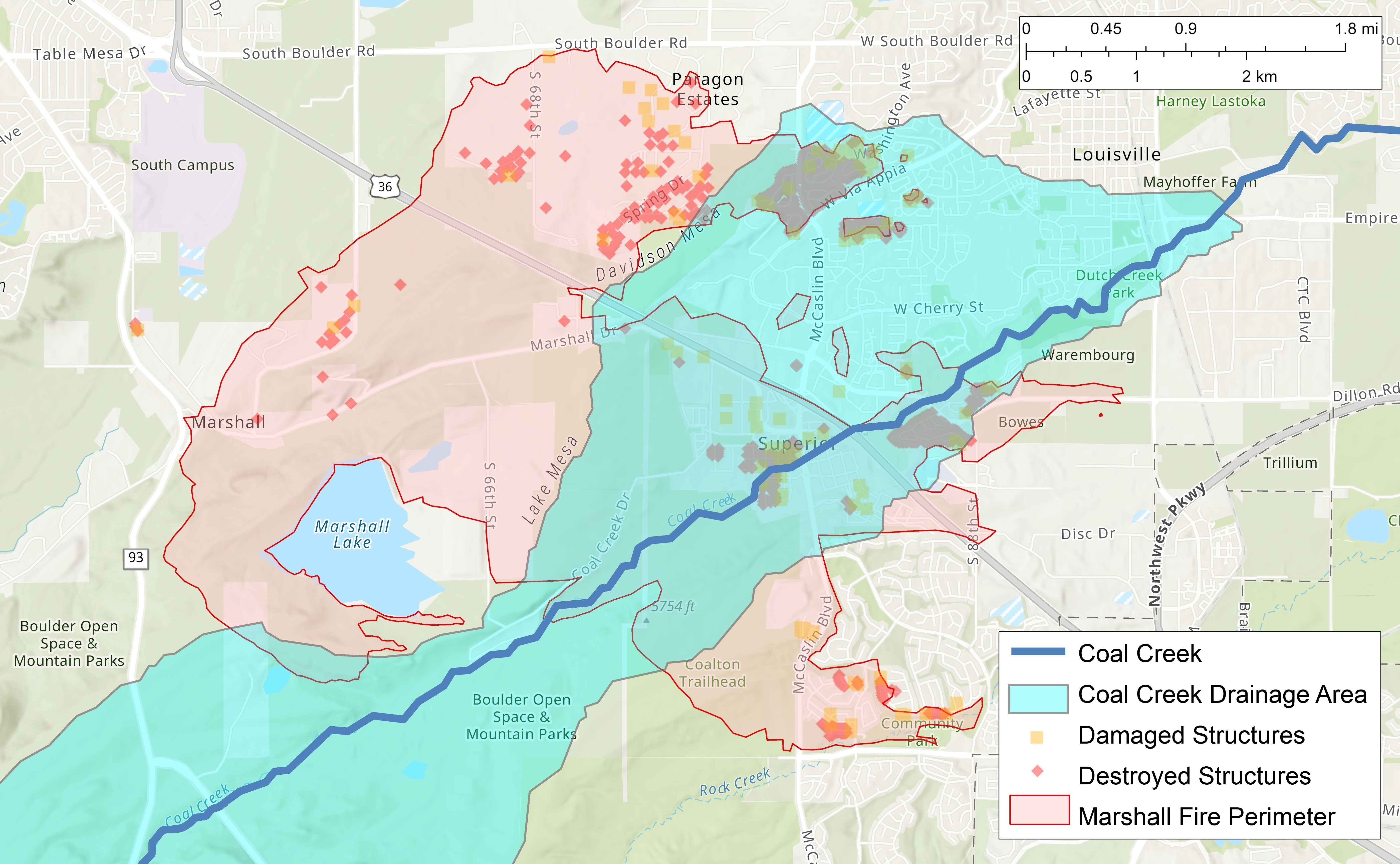
Our study aims to bridge a significant knowledge gap regarding wildland-urban interface (WUI) fires. Specifically, we investigated how the contaminants associated with WUI fires differ from those typically found in wildland fires. This research is particularly important for spring-fed streams like Coal Creek, which heavily relies on groundwater and storm runoff, rather than mountain snowmelt, for its baseflow. Given these conditions, Coal Creek is more vulnerable to the detrimental effects of urban pollution and faces an elevated risk of complex post-wildfire threats to its water quality. While numerous studies have explored the mobilization of material after wildland wildfires, there remains a scarcity of research focused specifically on WUI watersheds (National Academies of Sciences, Engineering, & Medicine, 20221).
The purpose of this study was to assess the impact of the 2021 Marshall Fire on water quality in the Coal Creek watershed over the course of eight months following the disaster. To achieve this, we conducted regular water quality monitoring between January and August 2022 at various sites along Coal Creek that were selected for comparative purposes, including multiple locations along the stream (e.g., upstream, within, and downstream of the burn area) in both urban and wildland environments. We hypothesized the following:
- The Marshall Fire would cause changes to the landscape surrounding the creek, including destabilizing sediment due to the combustion of vegetation and the deposition of ash and other burned materials.
- These changes would facilitate the mobilization of burned or destabilized materials to the streambed, particularly during precipitation events such as rain and snow melting.
- The introduction of these materials to the streambed would alter the water chemistry of the creek, resulting in high concentrations of constituents such as nutrients, dissolved organic carbon, and metals throughout the spring and summer months.
Our study was designed to test these hypotheses, and our results suggest that nutrients, organic carbon, and metals were likely mobilized into Coal Creek by the Marshall Fire. Metal concentrations that were observed within the study area exceeded the U.S. Environmental Protection Agency (EPA, n.d.)2 Aquatic Toxicity Criteria limits and these elevated levels of metals may pose a threat to the health of the stream and riparian ecosystems. However, it is important to note that post-Marshall Fire exceedances of these criteria limits may not lead to regulatory action, and that longer-term monitoring data is needed to categorically attribute elevated concentrations specifically to fire impacts.
Literature Review
How Wildfires Affect Water Quality in Wildland Watersheds
Wildfires can have significant consequences for water quality in wildland watersheds (Smith, et al., 20113). The burning process reduces the water retention capacity of soils, leading to increased hydrophobicity (or reduced ability for soil to absorb water) and increased surface runoff. This runoff transports total suspended solids (TSS), including ash, soil, and charred materials, into streambeds. Along with sediment load, such particles can contain elevated concentrations of potentially harmful substances such as polycyclic aromatic hydrocarbons and metals (Burke et al., 20104). If the sediment settles in stream beds, these substances may leach into the water (Burke et al., 20135). Additionally, wildfires alter the composition of organic materials, affecting their solubility and mobility within the watershed. For example, after a wildland fire, studies have shown an increase in dissolved organic carbon and dissolved organic nitrogen in waterways (Hohner et al., 20196; Raoelison et al., 20237). Nutrient levels, including nitrate, nitrite, ammonia, and phosphorus, also can increase following wildfires (Raoelison et al., 2023), potentially leading to eutrophication and detrimental effects on receiving waters, such as harmful algal blooms and fish kills (Bladon et al., 20148).
How Wildfires Affect Water Quality in the Wildland-Urban Interface
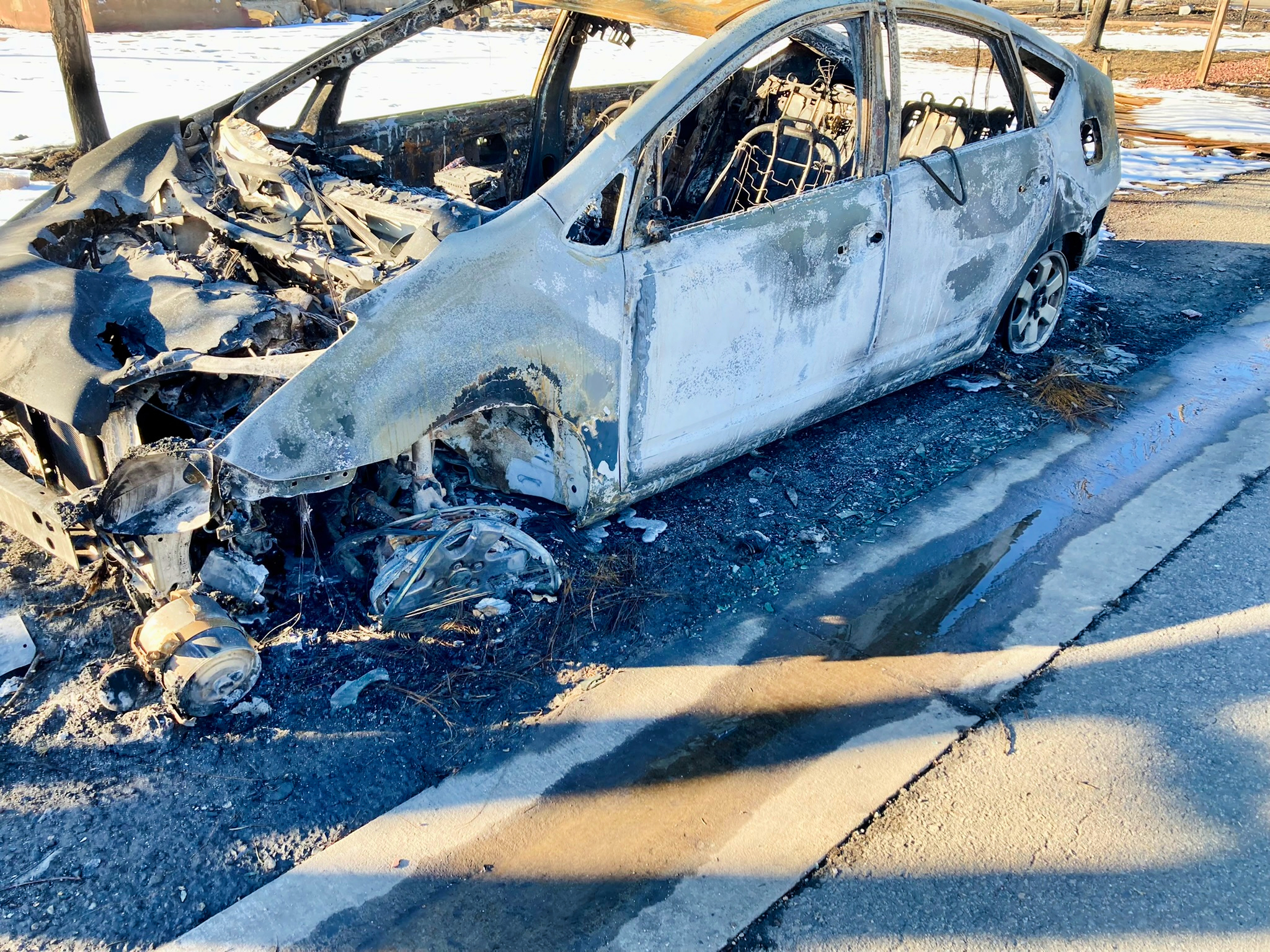
Wildfires occurring at the WUI introduce a more complex array of contaminants into watersheds compared to wildland fires. In addition to the natural contaminants associated with wildland fires, WUI fires involve the combustion of anthropogenic materials such as structures (residential, commercial, and industrial), electronics, household chemicals, vehicles, and more. Consequently, the resulting ash contains enriched levels of contaminants, including metals, which can be present in dissolved or particulate form. One particular concern is the high concentrations of metals that can be mobilized when snowmelt or rainwater washes through the debris left behind by the fire. This water, called runoff, carries dissolved and suspended contaminants creating contaminant-laden leachates. These leachates may pose a significant threat to the organisms that live in streams and rivers, potentially harming their health and survival (Blanck et al., 20039; Watzin & Roscigno, 199710). Previous studies investigating combusted anthropogenic materials or runoff from burned areas within WUIs have detected elevated concentrations of metals such as cadmium, chromium, copper, nickel, lead, and zinc (Burke et al., 2013; Lönnermark & Blomqvist, 200611; Raoelison et al., 2023). These metals may reach significantly higher concentrations after a WUI fire when compared to typical urban stormwater. For example, in two southern California WUI fires, copper, lead, and zinc were found to be present at levels 100 to 700 times higher in stormwater in burned areas compared to unburned areas (Stein et al., 201212).
While numerous studies have examined the post-fire mobilization of contaminants in wildland wildfires, limited research has focused on WUI watersheds (National Academies of Sciences, Engineering, & Medicine, 2022). One challenge for WUI fire studies is the ability to distinguish between metals (or other constituents) that directly result from the fire, versus those that originate from urban stormwater runoff in the absence of a fire, and also versus constituents that may not be considered a contaminant due to natural occurrence in the environment (e.g., from the underlying geology). The term constituent is used when it may be inappropriate to describe the presence of something in the water as a contaminant. Urban stormwater runoff often contains elevated concentrations of metals and other organic constituents unrelated to fire influence. Therefore, it is crucial (and difficult) to differentiate between the constituent sources to comprehensively understand the extent of potential contamination resulting from WUI fires.
Urban Stormwater as a Source of Contaminants
As cities adopt stormwater control measures to safeguard water resources, it is crucial to investigate how stormwater carries pollutants. A recent multiagency study conducted across the United States examined stormwater from 50 runoff events at 21 sites (Masoner et al., 201913). The findings revealed that stormwater transports a significant mixture of harmful substances, including organic chemicals like polycyclic aromatic hydrocarbons, pesticides, pharmaceuticals, and other contaminants of concern, with some concentrations exceeding recommended limits. During heavy rain events, the impact of these contaminants was found to be comparable to the pollution discharged by wastewater plants on a daily basis (Masoner et al., 2019). Even in the absence of fires, further attention is required to manage the risks associated with urban stormwater runoff and protect the environment.
Research Questions
Our study aims to evaluate changes in water quality in the Coal Creek drainage area following the Marshall Fire. To achieve this, we aimed to answer three research questions:
- How did water chemistry change in Coal Creek during the first months after the Marshall Fire?
- How have post-wildfire conditions contributed to the level of constituents in Coal Creek?
- Do concentrations of specific metals in Coal Creek surpass the EPA's criteria for healthy aquatic systems or cause other concerns?
Research Design
To evaluate changes in water quality in Coal Creek following the Marshall Fire, we collected water samples from six different sites and analyzed the water chemistry, nutrients, dissolved organic carbon, and metal content. In the following sections, we describe our procedures for water sample collection, testing, and analysis.
Water Sample Collection Sites
We collected water samples from six sites in the Coal Creek drainage area to assess changes in water quality following the Marshall Fire. We sampled water in burned and unburned stream segments, as well as in wildland and urban areas, to discern constituents likely associated with these variables. To select the collection sites for water sampling, we collaborated with community partners, including The City of Boulder Open Space and Mountain Parks, Boulder County Parks and Open Space, and the City of Louisville. Our partners identified the need for monitoring in open space areas, such as the Superior Associates Open Space, and at the Colorado Tech Center Open Space, which is an urban, downstream site near the Louisville Wastewater Treatment Plant. Figure 2 displays the six water sample collection sites in our study and their relative burn and urban compositions.
Figure 2. Water Sample Collection Sites in the Coal Creek Drainage Area
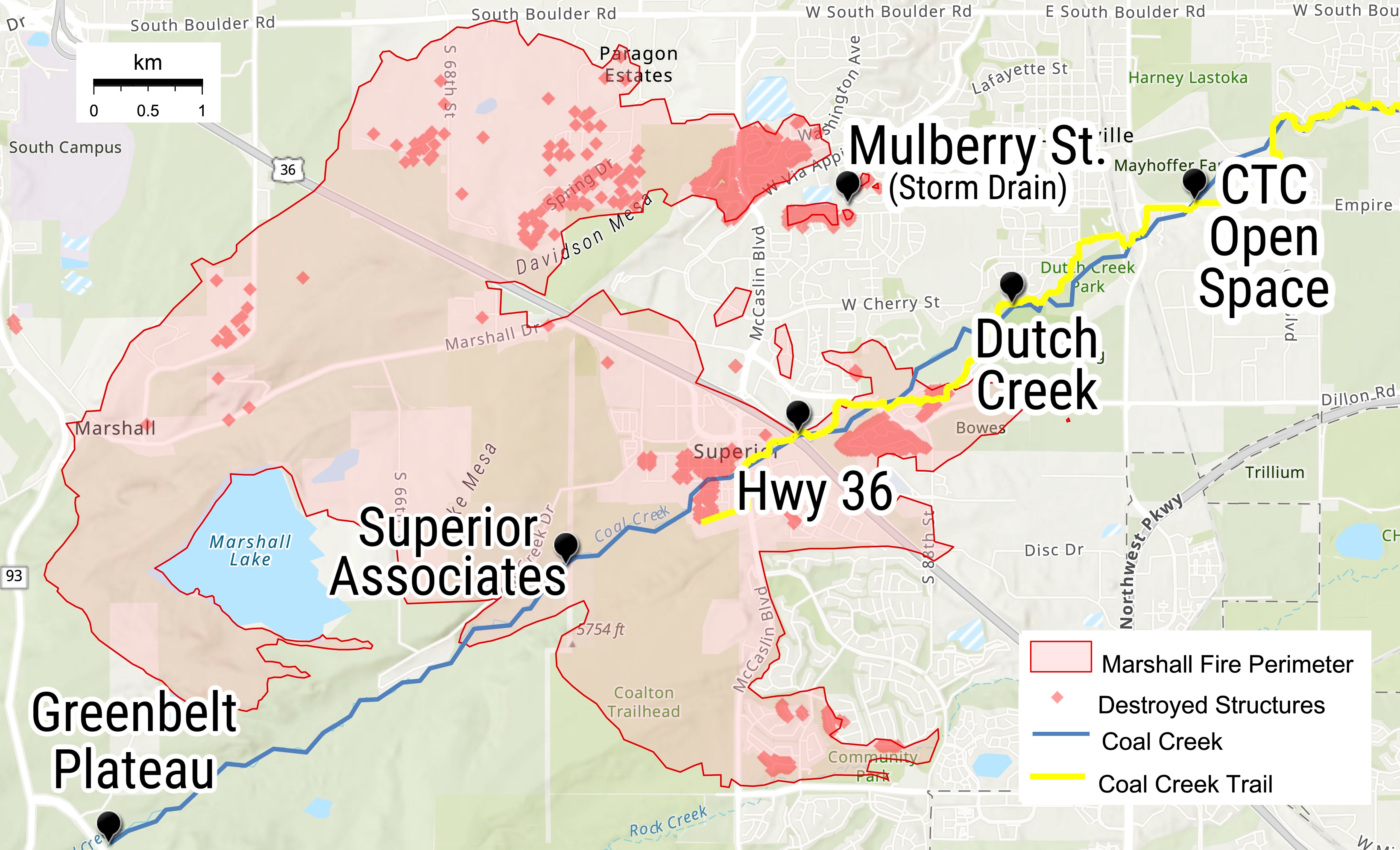
Table 1 provides a summary of the key features of each water sampling site. As the table shows, three sampling sites were located in the burn zone, two were located outside of urban development, and four were located in urban areas. It is important to note that the key features classifying sites are based on the most predominant features. All sites receive drainage from areas with a range of land uses and fire impacts. These mixed contributions at each site make categorical assessments of fire impact nuanced without long-term data.
Table 1. Description of Water Sample Collection Sites

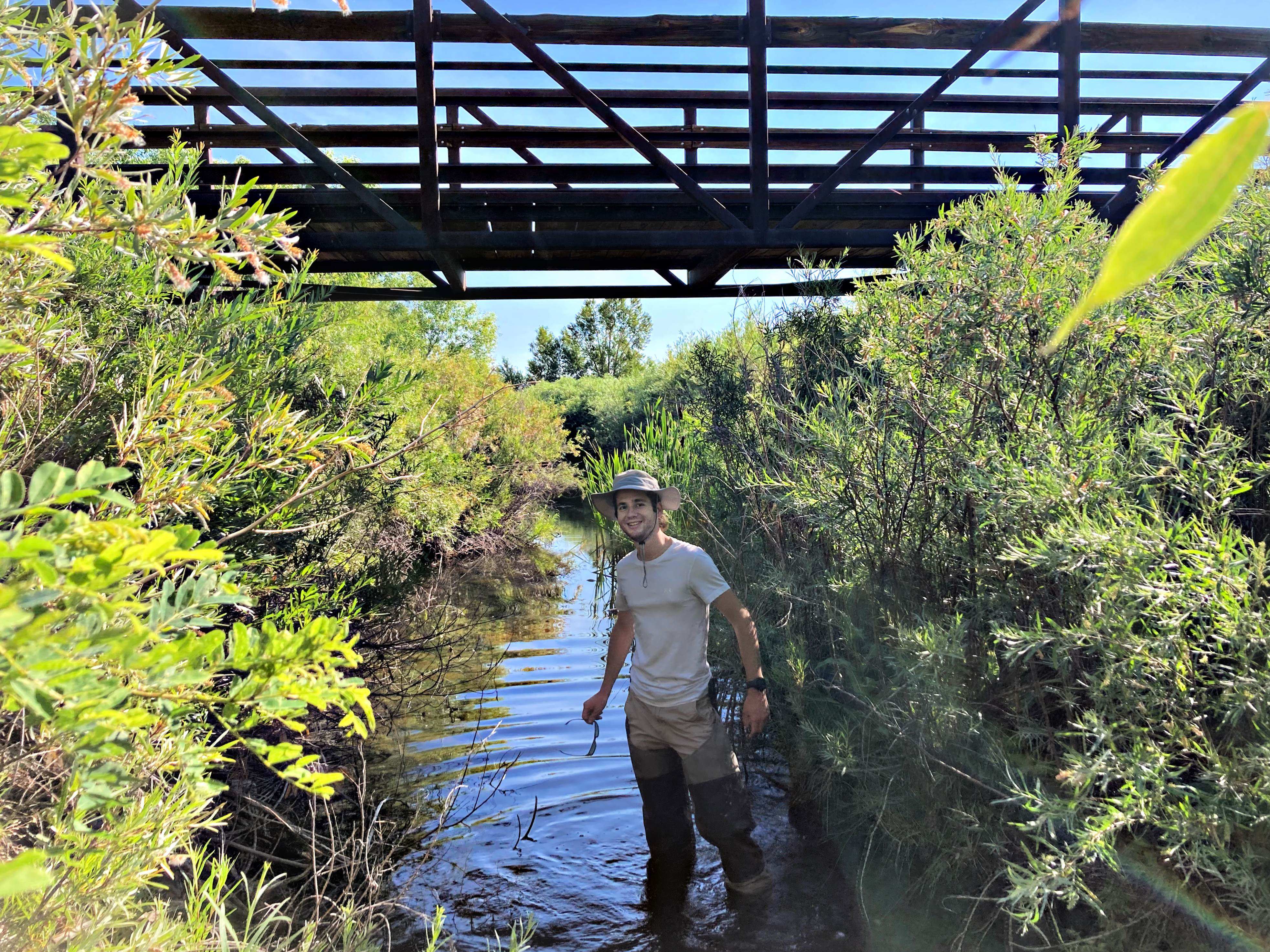
Site 1—Greenbelt Plateau (Unburned Wildland)
The first sampling site, Greenbelt Plateau, is located upstream of the burn area and outside of urban development. This site is situated on the Greenbelt Plateau Trail, is managed by the City of Boulder, and was chosen to serve as a reference site due to its healthy riparian area and distance from the burn perimeter. Downstream of site 1 and upstream of site 2, there is a water diversion structure, which is a dam that can open or close channels to temporarily divert water. This diversion structure can limit flow to downstream locations in Coal Creek by diverting to irrigation ditches. This structure can also divert water into Coal Creek from other drainage areas, which may impact downstream water chemistry. The complexity of water management practices limits how data collected downstream and upstream can be compared.

Site 2—Superior Associates (Burned Wildland)
The second sampling location, Superior Associates, is located in the burn zone and is characterized by heavily burned vegetation along the stream, indicating that burning occurred very close to the streambed. This location is also located upstream of urban development in an open space with a riparian corridor managed by the City of Boulder. The riparian corridor is dominated by native willows and cottonwoods, which provide habitat for a variety of wildlife, including a colony of Northern Leopard Frogs. Highly eroded stream banks at this location suggest that sediment input from upstream has been limited, likely due to the Community Ditch diversion structure located upstream.
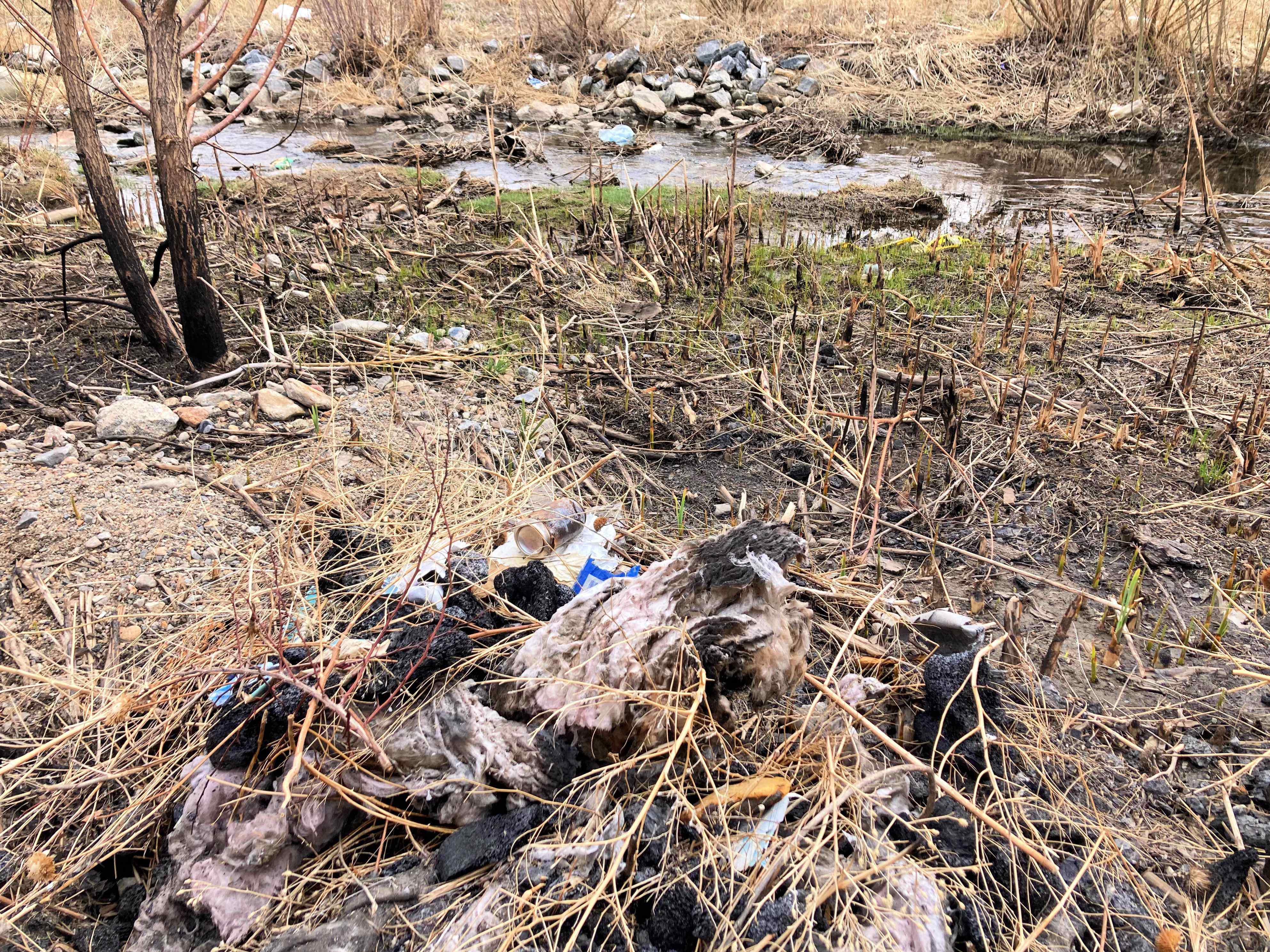
Site 3—Highway 36 (Burned Urban)
The third site, Highway 36, is in the burn area where the Coal Creek Trail crosses beneath Highway 36. While there is no evidence of extensive burning in the immediate vicinity of the streambed, this site is impacted by stormwater runoff from fire-affected residential and commercial areas in the Town of Superior. Additionally, the stream at this location is adjacent to a hotel that was destroyed in the fire, and structural debris (e.g., insulation) has been observed in the streambed representing a potential source of contaminants.
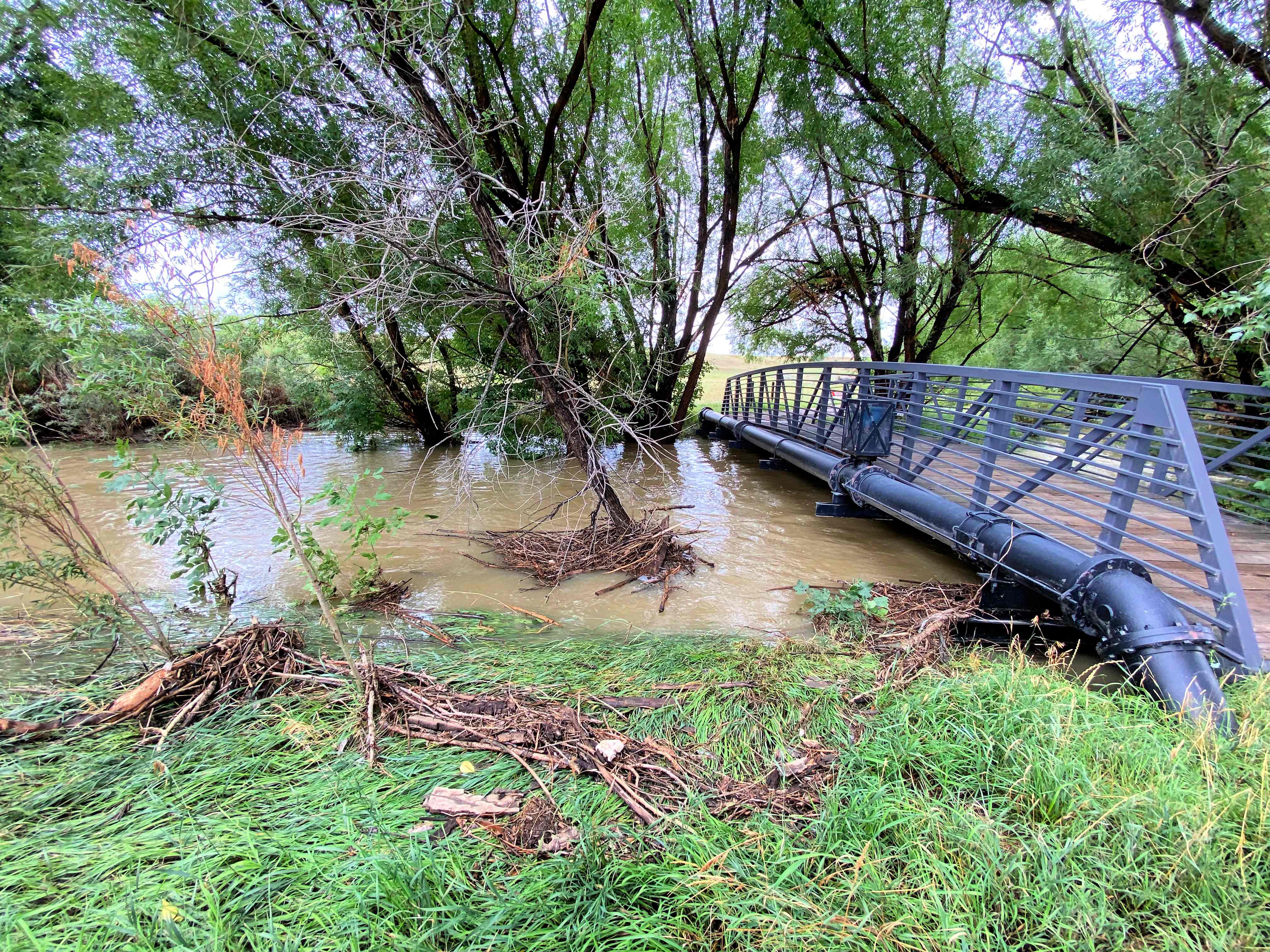
Site 4—Dutch Creek Park (Semi-Burned Urban)
The fourth sampling site, Dutch Creek Park, is in the City of Louisville downstream of the burn area. It captures runoff from residential and commercial areas impacted by the fires. Dutch Creek Park is a popular recreational area that includes a playground and picnic facilities, and it is adjacent to a golf course. The proximity of the park to the burn area makes it an important location for assessing the impact of the fires on water quality in a public recreation area.
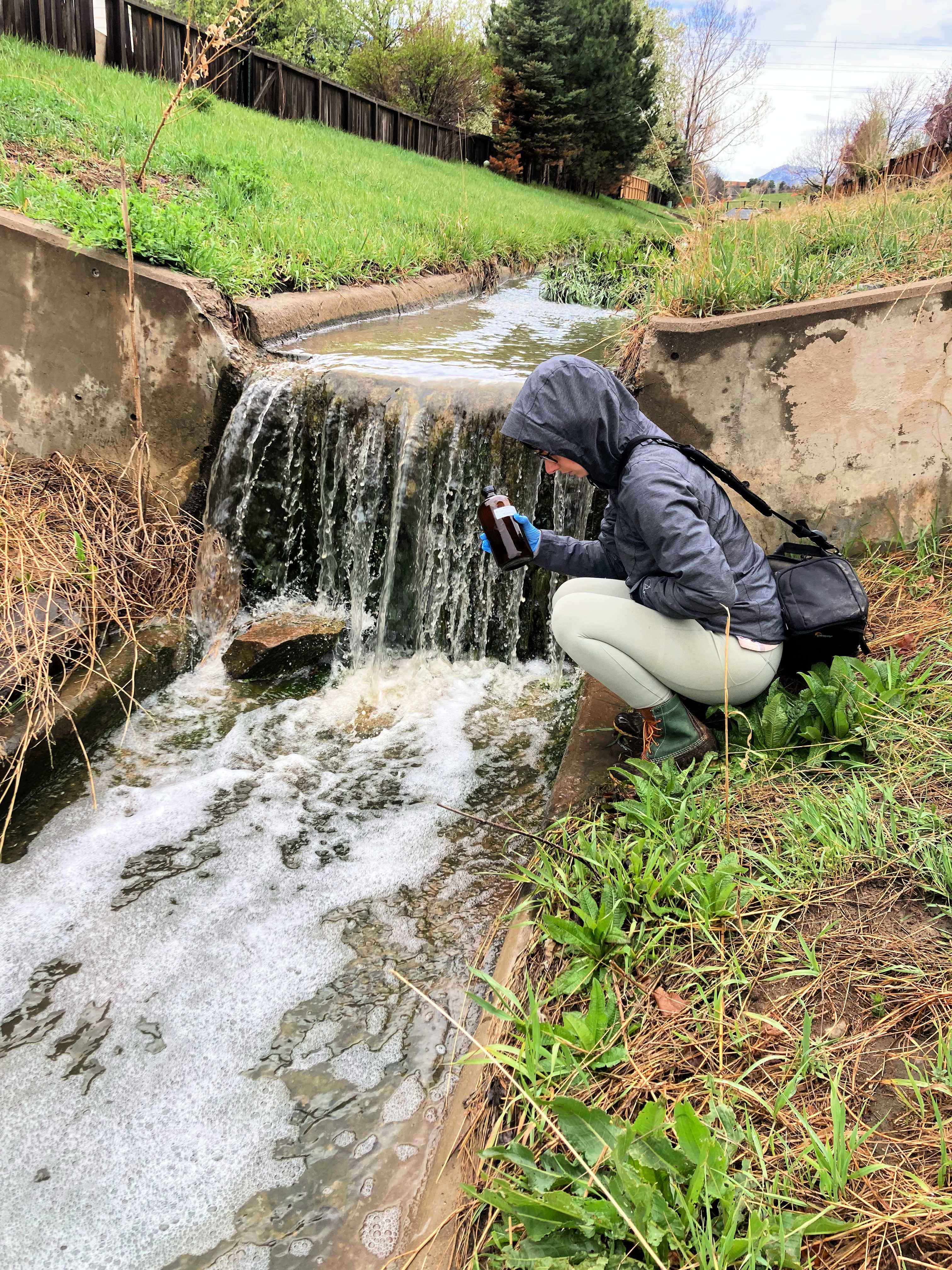
Site 5—Mulberry Storm Drain (Burned Urban)
The fifth sampling location, the Mulberry Storm Drain, is an engineered structure designed to collect stormwater runoff from surrounding neighborhoods. It is within the burn area and receives runoff from northwest Louisville, near the McCaslin Boulevard and Via Appia Way intersection, where there was a high density of destroyed structures. We chose this site to represent an urban point source impacted by fire that is not adjacent to a riparian area. Unlike sites with riparian areas, this site lacks vegetation, which supports natural attenuation processes that can reduce the mobilization of materials into the streambed following a fire. The water collected in this storm drain enters the main stem of Coal Creek downstream of Dutch Creek Park.

Site 6—Colorado Tech Center (Unburned Urban)
The sixth site, located at the Colorado Tech Center (CTC) Open Space and managed by the City of Louisville, is an unburned location in a highly urban area downstream of the Marshall Fire but upstream of the Louisville Wastewater Treatment Plant. It was selected to capture runoff from unburned urban areas downstream of the burn area, such that the site will receive more runoff from unburned, urban areas compared to the DCP site upstream. The CTC Open Space area is primarily a mix of commercial and light industrial development. The water samples collected at this site will provide insight into the potential impacts of post-fire urban runoff on water quality in Coal Creek.
Water Sample Collection Process
Water samples were collected during precipitation events and during baseflow. Baseflow is the flow in the stream sustained between precipitation events. Water from precipitation events, including rain and melted snow, runs over the local landscape and enters Coal Creek. Through this process, constituents from the landscape, including ash from the fire, may be mobilized into the water. Both intensity and total volume of water from a precipitation event can impact the amount and extent of material transport. Snow typically melts slowly, providing small volumes of water with low intensity. Rain events may be intense and can rapidly create high volumes of water. Sampling at baseflow was planned to help determine how constituent concentrations change during precipitation events.
This study collected baseflow measurements from the six sites one time per month. Additional samples from each site were collected immediately following precipitation events. Figure 3 shows the timing and progression of precipitation and sampling events throughout the first eight months after the fire. All samples collected from January through mid-March 2022 were during snowmelt conditions. Sampling in mid-March through April sampled baseflow conditions. The first appreciable rain event, with rain over several consecutive days, occurred in early May. Mid-June through late July had no appreciable precipitation events. The rain event in late August (16-18) caused flash flooding in some areas.
Figure 3. Time Series of Local Precipitation, Sampling Events, and Debris Removal

Note. Red vertical lines indicate sampling events. Gray shaded area depicts snow precipitation events. Green shaded areas show sampling events categorized as baseflow. Blue shaded areas show sampling events during or after precipitation events. Precipitation data from the National Weather Service Daily Precipitation Data.
Sampling Site Availability
In the initial weeks after the fire, water quality monitoring focused on two sites due to accessibility: Mulberry Storm Drain and Dutch Creek Park. Sampling at the upstream reference location, Greenbelt Plateau, started at the end of January. Between the two urban locations, the storm drain represents a point source that is heavily impacted burned residential areas. Other sites were accessible from February or March 2022 onward through the end of the study period in August 2022.
Water Quality Parameters
Grab samples were collected at each field site and transported them to the University of Colorado laboratory for filtration, preservation, storage, and analysis. Water samples were analyzed for typical bulk water quality parameters, nutrients, dissolved organic carbon, and metals. In the following subsections, we describe each water quality measure.
Bulk Water Quality Measures
Bulk water quality parameters measured in this study included alkalinity, pH, temperature, specific conductivity, turbidity, and total suspended solids. These parameters are important to measure after wildfires due to their potential impacts on water quality and ecosystem health and may be indicators of fire effects on the stream. For example, alkalinity (the acid-neutralizing capacity of filtered water, measured as calcium carbonate equivalents) is important to measure due to its role in stabilizing the pH of the stream, which, like temperature, impacts the solubility and toxicity of other substances in the water. Specific conductivity can indicate the presence of dissolved salts or other conductive materials, which may indicate changes in geologic materials, land use, or anthropogenic activities. Turbidity, a measure of light scattering due to suspended particles, impacts light penetration and affects the growth of photosynthetic organisms, which can have cascading effects on the rest of the ecosystem. Total suspended solids, another measure of the particles present in the stream, can increase turbidity, affecting water clarity, and may also indicate an increase in the quantity of sediment and particulate metals mobilized into the stream. Temperature, pH, and specific conductivity were measured in the field using probes (Yellow Spring Instruments (YSI) Pro1030 pH and Conductivity Meter). Turbidity was measured with a HACH 2100N turbidimeter and total suspended solids were measured by obtaining the mass of dried filters to calculate the difference in mass after filtration and drying at 65oC for 24 hours.
Dissolved Organic Carbon
Dissolved organic carbon measures the concentration of carbon in a water sample that is in the dissolved form (i.e., passes through a filter) and organic in nature. Dissolved organic carbon concentrations can influence the behavior and toxicity of other constituents, including metals, by altering their availability to organisms. The determination of dissolved organic carbon and total dissolved nitrogen was conducted using the high temperature combustion method (Shimadzu TOC-V).
Nutrients
Nutrients, such as phosphorus and nitrogen, are important to measure because elevated concentrations can cause harmful algal blooms and other ecological imbalances in aquatic systems. The dissolved organic nitrogen concentration was calculated by the difference of total dissolved nitrogen from the sum of nitrate, nitrite, and ammonia. Low concentrations of dissolved organic nitrogen may not be statistically different due to the analytical uncertainty of the underlying measurements.
Trace and Major Metals
Measuring metals such as zinc, copper, lead, and nickel is of particular interest following WUI fires due to the combustion of anthropogenic materials that likely contain metals (e.g., vehicles, wiring, building frames) and due to the potential toxicity of metals to aquatic organisms and humans when present at concentrations that exceed toxicity or hazardous thresholds. Additionally, the presence of certain metals, like manganese, in water used as a drinking water source can lead to aesthetic concerns. Also, lithium has recently been included in the EPA Contaminant Candidate List (EPA, 202214), indicating it may be considered for future regulation in drinking water. Therefore, it is important to monitor a wide range of metals beyond those currently regulated for aquatic life to fully understand the impacts of WUI fires on streams used for a variety of uses. This study analyzed a broad suite of metals to try to identify unique constituents that are uncommon in wildland fires but may be mobilized in WUI fires. An elemental analysis of trace and major metals using filtered (dissolved) and unfiltered (total) samples for a suite of 22 elements via inductively coupled plasma-mass spectrometry (Agilent 7900) was conducted. With paired (filtered and unfiltered) samples, the presence of different chemical elements (i.e., atoms) and the predominant form (dissolved vs. particulate) can be ascertained. This report focuses on elements that were frequently detected or are of particular importance to the riparian ecosystem health, including aluminum, copper, lead, lithium, manganese, nickel, and zinc.
Constituent Source Analysis
Water quality data was analyzed with respect to site and flow regime (baseflow vs. storm runoff) using boxplots and time series. Constituents that exhibited the highest concentrations in the unburned wildland site (Greenbelt Plateau) while remaining low in all other sites were interpreted as likely to originate from the unburned wildland portion of the drainage area. Conversely, constituents that displayed elevated concentrations in the burned wildland reach of the creek at Superior Associates but were lower at all other sites were considered to likely have been contributed by burned wildland sources. Furthermore, constituents that exhibited the highest concentrations at the two burned urban sites (Highway 36 and Dutch Creek Park) yet were lower in the unburned urban site (CTC) were attributed to burned urban sources. Constituents that exhibited the highest levels at CTC were interpreted as likely related to non-fire, urban activities.
The sampling campaign involving all six sites commenced in March 2022. Initial sampling in January and February was limited to Greenbelt Plateau (unburned, non-urban), Dutch Creek Park (burned, urban), and the Mulberry Ditch (storm drain, burned), providing a basis for examining temporal trends at these three sites for consistency.
Another important context for data interpretation is the timing of debris removal with different hydrologic events. Coordinated debris removal efforts started in May 2022. Although effective by physically removing potential contaminants from the environment, the coordinated debris removal of ash and other hazardous fire materials carries the risk of inadvertently disturbing these materials and mobilizing additional material during the cleanup process. Snowmelt sampling is expected to show the most amplified signals for fire impacts, as debris was progressively removed during the rain events. All graphs were generated using MATLAB by MathWorks.
Ethical Considerations and Reciprocity
We conducted our research with a strong commitment to ethics, ensuring the preservation of the natural habitat, public access, and the social and cultural significance of the sampled sites. All our sample sites were situated on public land, and we obtained the necessary permits to conduct research in these locations. To maximize the benefits and prevent redundant efforts, we collaborated closely with local municipalities and community collaborators. Additionally, we implemented rigorous research protocols to minimize any negative impacts on the environment. These protocols included the requirement for research team members to adhere to a “leave no trace” policy and to employ appropriate decontamination procedures to mitigate any adverse effects on the local ecosystem, particularly in sensitive areas.
As part of our project, we also prioritized reciprocity by incorporating activities that directly benefitted the community. For instance, we held regular meetings with several members of the Keep It Clean Partnership, as well as other interested partners including local non-profit organizations and State of Colorado agencies. Furthermore, we developed a publicly accessible website featuring a data dashboard where we shared the preliminary results of our water sample analysis. The data dashboard can be found on the Keep It Clean Partnership website.
Findings
In the following sections, we present selected water chemistry results in Coal Creek, and discuss the major trends observed with respect to sampling location, time, and flow type (e.g., snowmelt, baseflow, rain). This report additionally includes selected trace and major metal concentrations and all EPA aquatic life criteria limit exceedances measured within or downstream of the burn zone. We also discuss if these trends provide evidence of potential impacts on water chemistry in Coal Creek as a result of the Marshall Fire.
During the initial post-fire runoff events, often referred to as the “first flush” events, samples from the more urbanized burned site had higher concentrations of carbon, nitrogen, and turbidity compared to samples from burned wildland site (Superior Associates), the unburned reference site (Greenbelt Plateau), or the urban site downstream of the burn (CTC). The increased transport of carbon and nitrogen to riparian environments carries significant implications, particularly for the abundance and distribution of periphyton and macroinvertebrates residing in the streambed. Nutrient enrichment can lead to the development of harmful algal blooms, which in turn deplete the water of oxygen, negatively affecting other aquatic organisms. Surprisingly, this study found that the highest nutrient concentrations were observed during winter, which may have limited the expected adverse impacts because many aquatic biota and periphyton species are less active in the winter months.
Changes in Bulk Water Quality Parameters, Dissolved Organic Carbon, and Nutrients
Within the first eight months of sampling following the Marshall Fire, the water quality constituents measured in this study were contributed by a combination of sources. For example, the measure of conductivity, which increases as the concentration of dissolved salts in the water increases, was highest between January and March (Figure 4A). There were no significant differences between the Mulberry Storm Drain and Dutch Creek Park sites, suggesting that runoff from urban areas of mixed fire impacts had similar concentrations to the storm drain. The high salinity may be associated with road salt application rather than wildfire impacts (Marsalek, 200315; Snodgrass et al., 201716). In addition, the water pH was consistently higher at the storm drain (Mulberry) compared to other sites (Figure 4B). The increased pH levels at the storm drain were observed consistently from January to September, indicating more alkaline water chemistry. On the one hand, elevated pH may be due to runoff of materials from fire-impacted areas or, on the other hand, due to the prolonged contact between water and concrete materials used in storm drain systems. Our evidence suggests that some of these changes may be due to the runoff from the fire-impacted WUI, while others are the result of typical seasonal changes in the urban environment.
Figure 4. Bulk Water Quality Parameters
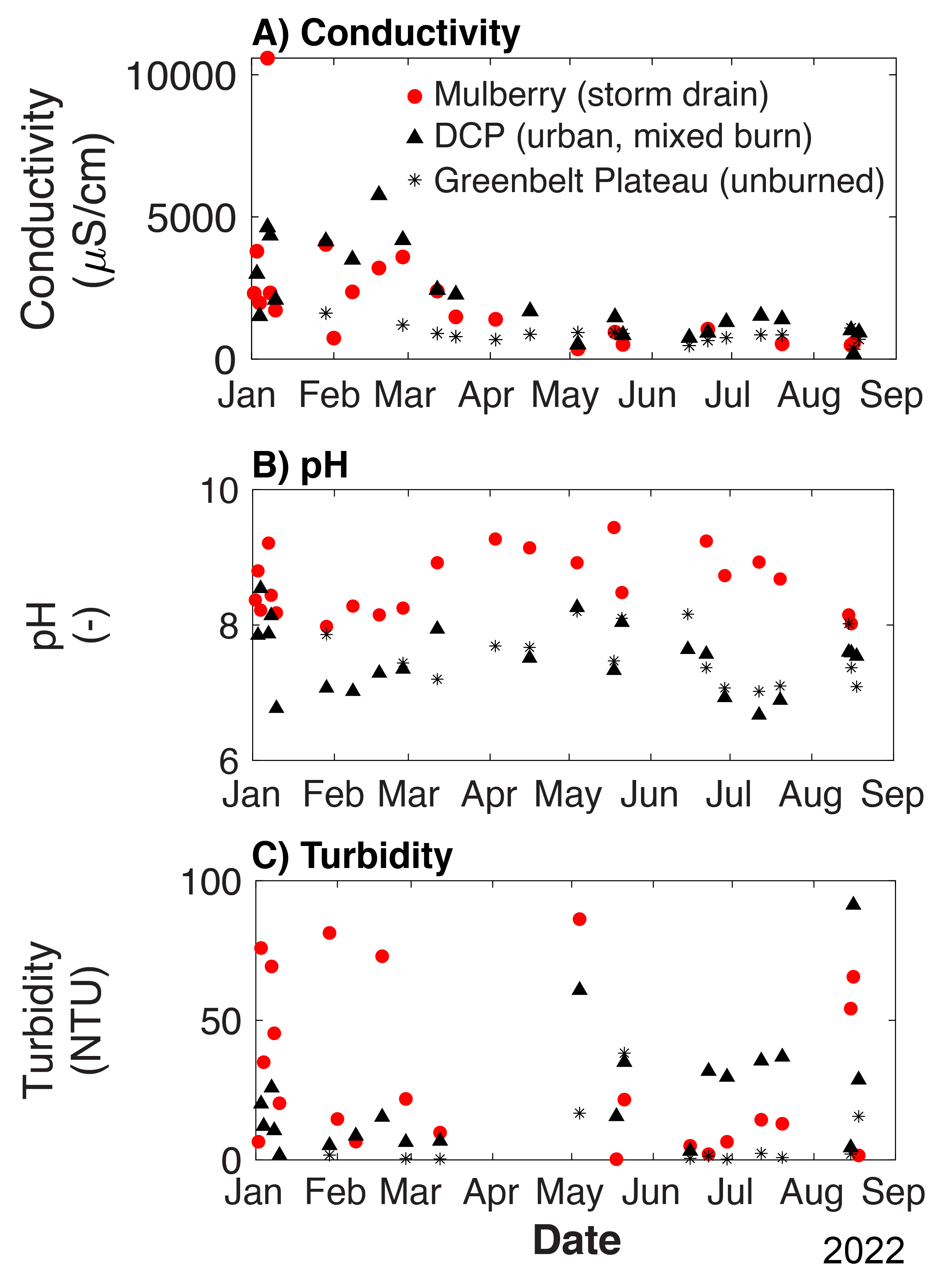
In contrast, turbidity was higher at the Mulberry Storm Drain during early snowmelt events and summer rain events, compared to Dutch Creek Park (Figure 4C). However, during baseflow sampling events, turbidity was similar to or higher at Dutch Creek Park. Elevated turbidity suggests that the runoff from wildfire-impacted areas contributed to increased transport of particulate material, such as sediment and solid contaminants, in the watershed.
Dissolved organic carbon (DOC) measurements showed the highest concentrations in the initial runoff samples following the fire (Figure 5A). Subsequent snowmelt events exhibited lower DOC concentrations, yet consistently higher levels were observed at the storm drain site compared to other locations. These findings suggest that burned areas contributed a greater amount of soluble organic compounds to the watershed than typical urban runoff in the area. In terms of total dissolved nitrogen (TDN), the storm drain consistently exhibited higher concentrations throughout the sampling period (Figure 5B), indicating an elevated nitrogen in runoff from burned urban sources.
Figure 5. Dissolved Organic Carbon and Total Dissolved Nitrogen
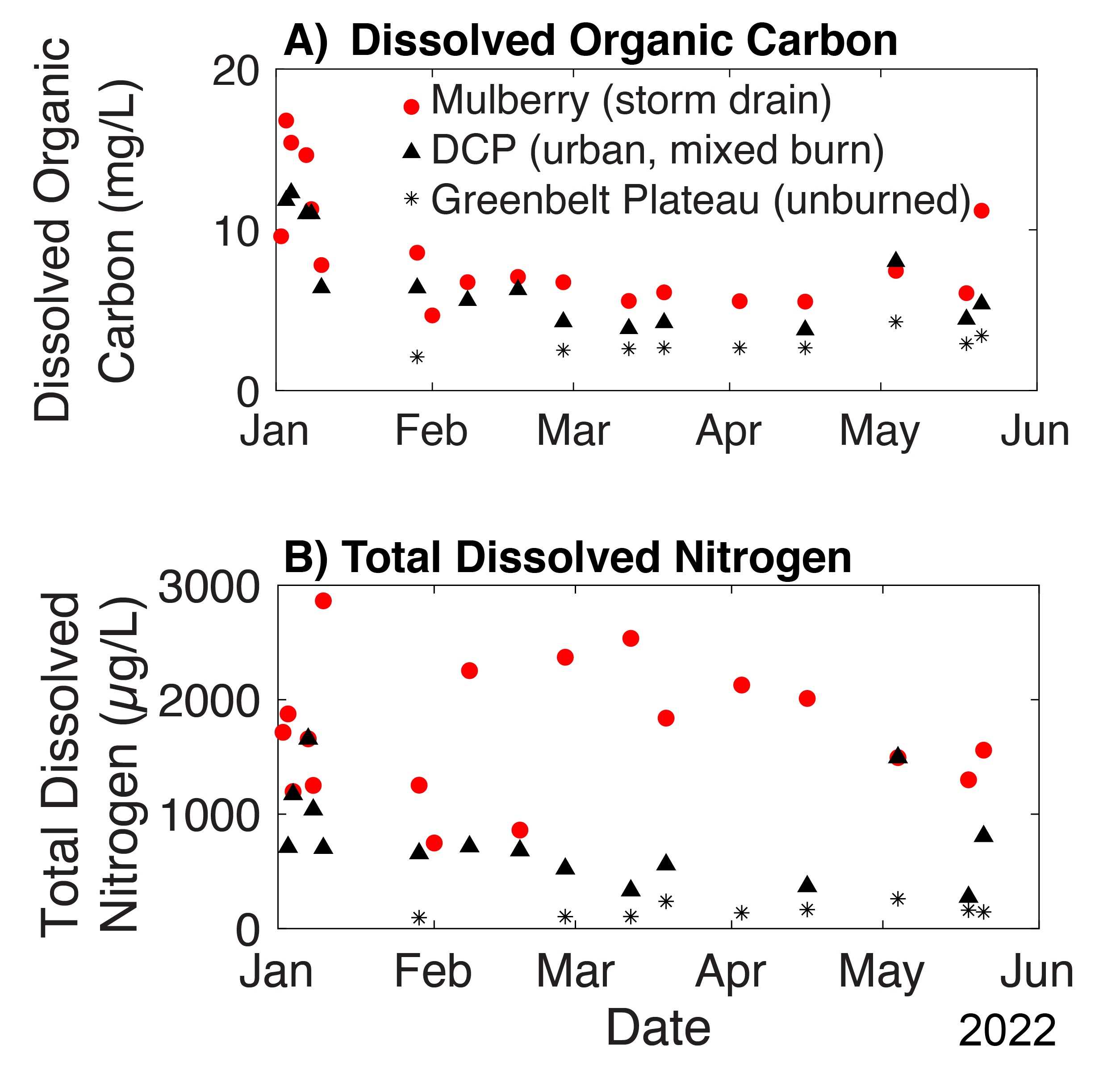
In addition to total dissolved nitrogen measurements, samples were analyzed to determine the type of nitrogen present. Ammonia was the dominant nitrogen form at the Mulberry Storm Drain on January 7, while organic nitrogen was dominant at Dutch Creek Park. As the sampling events progressed in January, the dominant nitrogen forms shifted to nitrate and nitrite or organic nitrogen at fire-impacted sites (Figure 6).
Figure 6. Dissolved Nitrogen Speciation During First Flush in January 2022

Note. DCP refers to Dutch Creek Park, while CTC refers to the Colorado Tech Center Open Space. These findings highlight how the Marshall Fire may have impacted the water chemistry of Coal Creek, including higher dissolved organic carbon, elevated turbidity, and varying forms of nitrogen. These changes may have implications for the health of the aquatic ecosystem and highlight the impact of fire on water quality in Coal Creek.
Changes in Trace Metal Concentrations
This section presents the results of our analysis regarding trace metal concentrations in Coal Creek and a contributing storm drain. Specifically, we will discuss a subset of the findings that are particularly relevant due to their ecologically relevant concentrations and potential toxic implications for the stream ecosystem. The metals of interest include lithium (Li), manganese (Mn), aluminum (Al), zinc (Zn), and copper (Cu). Through our analysis, we aimed to attribute the sources of these metals in Coal Creek after the Marshall Fire, but these assignments are nuanced due to mixed runoff sources at each site.
Figure 7A demonstrates that total manganese concentrations increased downstream through the Dutch Creek Park site but decreased at the Colorado Tech Center site. Interestingly, concentrations at the storm drain were lower than at upstream sites, suggesting that the elevated total manganese levels may be associated more with fire-impacted wildland areas than urban areas. This pattern was only observed during snowmelt events and not for subsequent baseflow or rain sampling events. During rain events and baseflow, the highest concentrations of total manganese were measured at Dutch Creek Park immediately after the fire. However, in August rain events, the highest concentrations were observed at the Colorado Tech Center site. These differences suggest that there are potentially different sources in the watershed, but the samples collected initially after the fire suggest predominantly wildland sources.
Figure 7. Trace Metal Concentrations of Total Manganese and Dissolved Lithium
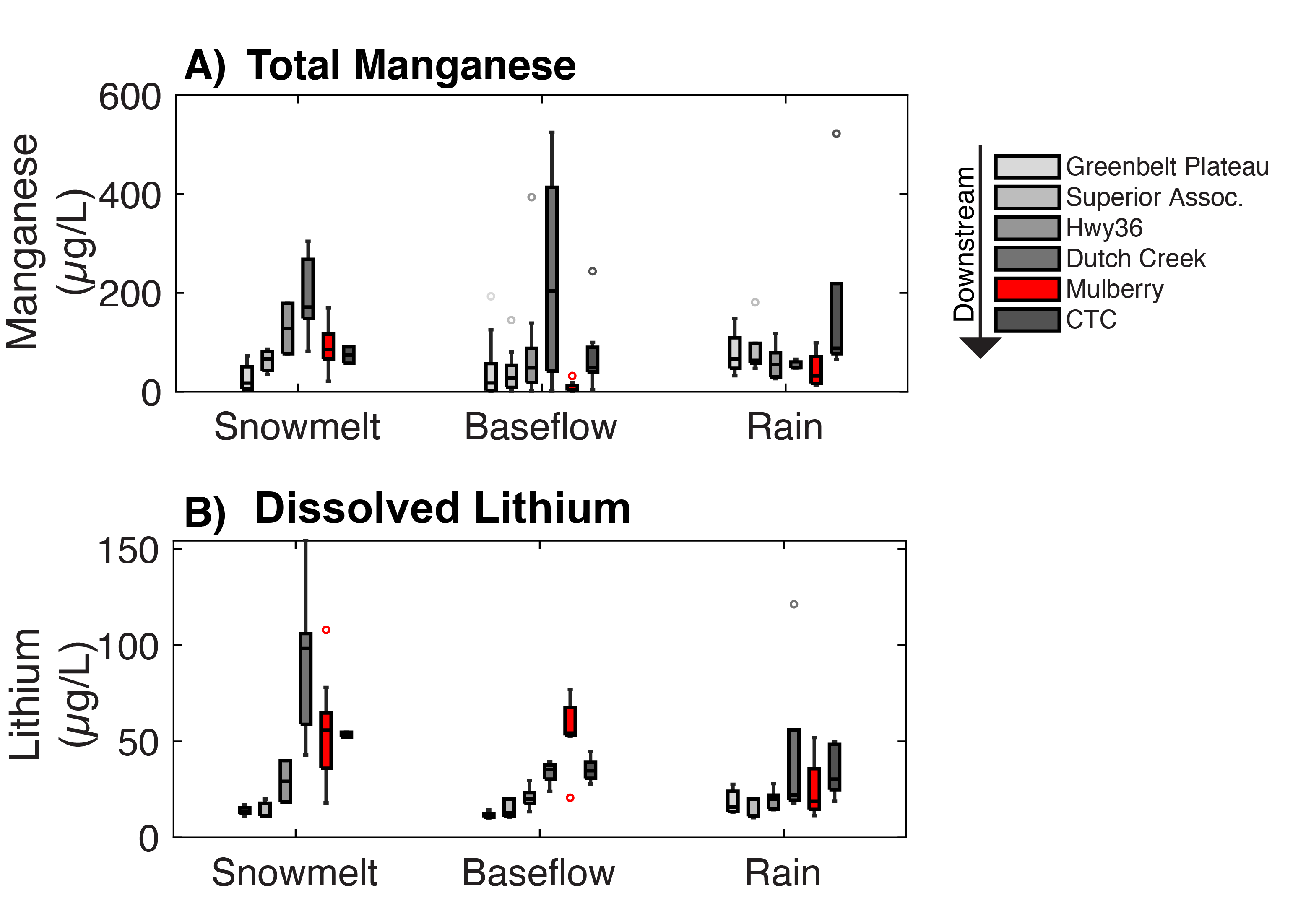
Dissolved lithium exhibited a similar pattern during snowmelt and baseflow sampling, with increasing concentrations observed through the fire-impacted urban corridor. Concentrations increased at Highway 36, peaked either at Dutch Creek Park or the Mulberry Storm Drain, and then decreased at the Colorado Tech Center site. These findings suggest that the primary source of mobilized lithium in the watershed may be the fire-impacted urban areas.
Figure 8 shows concentrations of total aluminum (Al), dissolved copper (Cu), and total zinc (Zn). Total aluminum exhibited the highest concentrations during snowmelt at the Superior Associates site, indicating a potential wildland fire source. Additionally, high concentrations were observed at the Mulberry Storm Drain, which could also indicate a potential urban fire source. During baseflow, the highest concentrations also occurred at the Superior Associates site. Rain events generally showed a trend of urban non-fire inputs or typical urban stormwater, with a small increase at Highway 36. For dissolved copper, high concentrations were observed during snowmelt at Highway 36 and, at times, in the rain runoff at the Mulberry Storm Drain. However, baseflow sampling indicated a strong non-burned urban source of copper, obscuring any clear trends in potential source attribution. Total zinc also demonstrated the possibility of multiple inputs. During snowmelt, elevated total zinc was observed at the Colorado Tech Center site, which has relatively more runoff from unburned urban areas than Dutch Creek Park. However, both baseflow and rain events showed elevated concentrations at sites with predominately unburned wildland or burned urban sources. Overall, our findings indicate that the Marshall Fire likely contributed metals to Coal Creek, but it was not the sole contributor. Unburned wildland inputs, such as geological materials, and unburned urban inputs, such as typical urban pollution in runoff water, also played a significant role in contributing these metals into the stream.
Figure 8. Trace Metal Concentrations of Aluminum, Copper, and Zinc

Environmental Protection Agency Criteria Exceedances and Other Considerations
Regardless of source, the observed concentrations of trace metals in the water samples have potential ecological and public health implications. The EPA (n.d.) has established "aquatic life criteria" thresholds that define the maximum allowable concentrations of trace metals in waterways over extended (chronic, 4 days) or short (acute, 4 hours) periods without seriously endangering the health of aquatic ecosystems.
As Table 2 depicts, our analysis showed that the concentrations of copper, nickel, lead, and zinc observed in individual grab samples exceeded the EPA thresholds multiple times, indicating that these trace metals may have been present at levels that pose potential ecological risks. The sampling methodology in this study did not assess if the concentrations exceeded the thresholds for the prescribed durations in the EPA criteria. However, these findings highlight the ecological significance of elevated trace metal levels observed following the Marshall Fire. It is important to note that post-Marshall Fire exceedances of these criteria limits may not lead to regulatory action.
Table 2. Trace Metals in Excess of Aquatic Life Criteria Between January and August 2022
| Copper | ||
| Nickel | ||
| Lead | ||
| Zinc |
Elevated lithium and manganese concentration have potential implications for water sources used for drinking water. Lithium has recently been included in the EPA’s (2022) Contaminant Candidate List for potential future regulation consideration in drinking water. While manganese is not subject to EPA regulations for aquatic life criteria, its presence presents challenges for drinking water treatment. Although this is not directly applicable to Coal Creek, it could be problematic for other municipalities facing potential WUI fires.
Conclusions
Our analysis of water chemistry parameters and trace metal concentrations revealed differences in contaminant concentration and chemical composition between sites and over the 8-month study period and uncovered several potential risks to the stream ecosystem. Understanding these dynamics and implementing effective management strategies is crucial for safeguarding water quality and ecosystem health.
The analysis of bulk water quality parameters demonstrated elevated dissolved organic carbon, increased turbidity, and multiple forms of nitrogen at some fire-impacted sites in the Coal Creek drainage area. These changes can negatively impact the abundance and diversity of aquatic organisms, including periphyton and macroinvertebrates (Ouyang et al., 201817). Nutrient enrichment, particularly of phosphorous and nitrogen, can lead to harmful algal blooms and oxygen depletion, posing risks to overall water quality and biodiversity. Our team is investigating the potential impact on aquatic organisms through long-term monitoring.
Additionally, the concentrations of trace metals in individual samples exceeded EPA thresholds for copper, nickel, lead, and zinc, indicating potential ecological risks associated with these elevated levels if the concentrations were sustained for prolonged periods. Further characterizing trace metal concentrations and exploring mitigation strategies could increase the long-term health of the aquatic ecosystem. Manganese and lithium, present in stretches impacted by burning, also warrant further attention.
Importantly, our study revealed that the contribution of trace metals in Coal Creek was likely from a complex mixture of sources. While the Marshall Fire likely played a significant role, we also observed contributions from unburned wildland areas and typical urban pollution. This highlights the need for comprehensive management strategies that address both fire-impacted and non-fire-related sources of contaminants.
In conclusion, the findings underscore the importance of understanding post-fire dynamics and implementing proactive pre- and post-fire management practices. By adopting these measures, we can protect water quality and preserve the long-term health of ecosystems. Effective collaboration among researchers, stakeholders, and policymakers is crucial in developing targeted strategies and ensuring the resilience of impacted areas.
Policy Impacts of Community-Based Research
The active involvement of stakeholders, including local non-profit organizations and land managers, greatly contributed to this study of Coal Creek water quality. This collaborative approach integrated scientific findings with practical expertise, ensuring the relevance and applicability of the research. Engaging communities and stakeholders throughout the decision-making process is essential to develop well-informed management efforts that address specific needs and align with local concerns, fostering collective responsibility for ecosystem resilience.
To effectively communicate our research findings and engage with stakeholders and the public, we utilized a publicly accessible data dashboard provided by the Keep it Clean Partnership. This platform allowed us to share our results, keeping stakeholders and the public informed about the study's progress and outcomes. Additionally, monthly stakeholder meetings were held to facilitate discussions on recent results, upcoming outreach events, the future direction of the research, and help address public concerns. These meetings provided valuable opportunities to foster dialogue, exchange information, and ensure that our research efforts were responsive to community needs and priorities.
The study's findings offer valuable insights for policymakers and land managers to protect surface water quality, particularly in WUI areas. Proactive strategies are crucial to mitigate post-fire soil erosion and reduce pollutant inputs during runoff events. Implementing techniques such as erosion control, vegetation restoration, and stormwater management play a vital role in minimizing ecological and public health risks. Furthermore, the identification of significant exceedances in metals like zinc, copper, lead, and nickel emphasizes the need to address their sources and potential impacts. Targeted strategies and mitigation measures should be prioritized to reduce metal inputs into streams and ensure the health and sustainability of aquatic ecosystems.
Additionally, establishing monitoring and assessment programs to track metal, carbon, and nutrients concentrations over time before fires happen will facilitate the identification of emerging trends and the need for further action to protect stream ecosystems. By utilizing platforms like the publicly accessible data dashboard and maintaining regular stakeholder meetings, research teams can effectively disseminate information, help address public concerns, and ensure transparency, accountability, and responsiveness in their research efforts. Through collaborative efforts and informed decision-making, the protection of water quality and preservation of long-term ecosystem health can be improved.
Limitations
While this study provides valuable insights into the potential impacts of the Marshall Fire on water quality in Coal Creek, limitations should be acknowledged. First, the duration of this study period was short (8 months). Without extensive historical data, multiple years of sampling after the fire and reconstruction efforts will be needed to fully understand the magnitude and extent to which the fire impacted the riparian ecosystem.
Additionally, limited hydrological connectivity exists between the reference site, Greenbelt Plateau, and other sites along Coal Creek, such as Superior Associates, due to the presence of the Community Ditch diversion structure. Despite this, the Greenbelt Plateau site remains a suitable reference site with a healthy riparian ecosystem, similar stream size, and likely similar groundwater inputs. However, the restricted flow of water and limited direct hydrological interactions should be considered when analyzing material transfer and overall water quality dynamics between sites.
Sampling durations varied among sites, affecting data aggregation. Mulberry Storm Drain and Dutch Creek Park were sampled shortly after the fire, while Greenbelt Plateau and Highway 36 were included by mid-January. Superior Associates and the Colorado Tech Center were added later based on stakeholder discussions, with sampling starting in February and March, respectively. As a result, early data, including first flush concentrations, primarily relied on observations from Greenbelt Plateau, Mulberry Storm Drain, and Dutch Creek Park. The variation in sampling periods introduces potential biases and may influence the understanding of temporal trends and patterns in water quality parameters across the study sites.
Intermittent desiccation or drying of streambeds at certain sites limited data collection during low-flow or completely dry periods, preventing grab sampling. This limitation may result in the omission of valuable information regarding spatial differences during those specific time periods. The intermittent dry periods should be recognized as they may impact the representation and understanding of water quality conditions in Coal Creek, particularly during critical hydrological events.
Future Research Directions
Building upon the existing study, the future direction of this research aims to provide a more comprehensive understanding of the long-term impacts of the Marshall Fire on water quality and ecosystem health in Coal Creek. This will be achieved through continued data collection and analysis, supported by additional funding from the State of Colorado.
The ongoing sampling efforts will extend beyond the initial study period, allowing for the collection of data throughout 2023. This extended timeframe will provide a two-year dataset, enabling the analysis of longer-term trends in water quality parameters and the health of the aquatic ecosystem. By examining the persistence of fire impacts on trace metal concentrations and other key indicators, this research will contribute valuable insights into the recovery and resilience of the affected watershed.
The focus of the future data collection will be on trace metals, including zinc, copper, lead, and nickel, among others. By assessing the trends and variations in these metal concentrations over the extended study period, the research team aims to further understand how the observations immediately after the fire align with a larger historical context. This knowledge will be crucial to inform effective management practices, enabling land managers and policymakers to implement targeted strategies for years following WUI fires.
The continuation of this study will enhance our understanding of the long-term ecological implications of wildfires and provide valuable data for assessing the persistence of fire impacts beyond the immediate post-fire period. By considering the dynamics of water quality and ecosystem health over an extended timeframe, the research outcomes will contribute to evidence-based decision-making and the development of sustainable management practices to mitigate the long-term effects of WUI fires on streams.
References
-
National Academies of Sciences, Engineering, & Medicine. (2022). The Chemistry of Fires at the Wildland-Urban Interface. The National Academies Press. https://doi.org/10.17226/26460 ↩
-
U. S. Environmental Protecting Agency (n.d.). National Recommended Water Quality Criteria - Aquatic Life Criteria Table. Retrieved July 2, 2023 from www.epa.gov/wqc/national-recommended-water-quality-criteria-aquatic-life-criteria-table63 ↩
-
Smith, H. G., Sheridan, G. J., Lane, P. N. J., Nyman, P., & Haydon, S. (2011). Wildfire effects on water quality in forest catchments: A review with implications for water supply. Journal of Hydrology, 396(1–2), 170–192. https://doi.org/10.1016/j.jhydrol.2010.10.043 ↩
-
Burke, Megan P, Hogue, T. S., Ferreira, M., Mendez, C. B., Navarro, B., Lopez, S., & Jay, J. A. (2010). The Effect of Wildfire on Soil Mercury Concentrations in Southern California Watersheds. Water Air and Soil Pollution, 212(1–4), 369–385. https://doi.org/10.1007/s11270-010-0351-y ↩
-
Burke, M. P., Hogue, T. S., Kinoshita, A. M., Barco, J., Wessel, C., & Stein, E. D. (2013). Pre- and post-fire pollutant loads in an urban fringe watershed in Southern California. Environmental Monitoring and Assessment, 185(12), 10131–10145. https://doi.org/10.1007/s10661-013-3318-9 ↩
-
Hohner, A. K., Rhoades, C. C., Wilkerson, P., & Rosario-Ortiz, F. L. (2019). Wildfires Alter Forest Watersheds and Threaten Drinking Water Quality. Accounts of Chemical Research, 52(5), 1234–1244. https://doi.org/10.1021/acs.accounts.8b00670 ↩
-
Raoelison, O. D., Valenca, R., Lee, A., Karim, S., Webster, J. P., Poulin, B. A., & Mohanty, S. K. (2023). Wildfire impacts on surface water quality parameters: Cause of data variability and reporting needs. Environmental Pollution, 317, 120713. https://doi.org/10.1016/j.envpol.2022.120713 ↩
-
Bladon, K. D., Emelko, M. B., Silins, U., & Stone, M. (2014). Wildfire and the Future of Water Supply. Environmental Science & Technology, 48(16), 8936–8943. https://doi.org/10.1021/es500130g ↩
-
Blanck, H., Admiraal, W., Cleven, R. F. M. J., Guasch, H., Hoop, M. A. G. T. van den, Ivorra, N., … Tubbing, G. M. J. (2003). Variability in Zinc Tolerance, Measured as Incorporation of Radio-Labeled Carbon Dioxide and Thymidine, in Periphyton Communities Sampled from 15 European River Stretches. Archives of Environmental Contamination and Toxicology, 44(1), 0017–0029. https://doi.org/10.1007/s00244-002-1258-4 ↩
-
Watzin, M. C., & Roscigno, P. R. (1997). The effects of zinc contamination on the recruitment and early survival of benthic invertebrates in an estuary. Marine Pollution Bulletin, 34(6), 443–455. https://doi.org/10.1016/S0025-326X(96)00132-4 ↩
-
Lönnermark, A., & Blomqvist, P. (2006). Emissions from an automobile fire. *, 62*(7), 1043–1056. https://doi.org/10.1016/j.chemosphere.2005.05.002 ↩
-
Stein, E. D., Brown, J. S., Hogue, T. S., Burke, M. P., & Kinoshita, A. (2012). Stormwater contaminant loading following southern California wildfires. Environmental Toxicology and Chemistry, 31(11), 2625–2638. https://doi.org/10.1002/etc.1994 ↩
-
Masoner, J. R., Kolpin, D. W., Cozzarelli, I. M., Barber, L. B., Burden, D. S., Foreman, W. T., Bradley, P. M. (2019). Urban Stormwater: An Overlooked Pathway of Extensive Mixed Contaminants to Surface and Groundwaters in the United States. Environmental Science & Technology, 53(17), 10070–10081. https://doi.org/10.1021/acs.est.9b02867 ↩
-
Environmental Protection Agency. (2022, November 14). Drinking Water Contaminant Candidate List 5-Final. A Rule by the Environmental Protection Agency. National Archives Federal Register. www.federalregister.gov/d/2022-23963 ↩
-
Marsalek, J. (2003). Road salts in urban stormwater: an emerging issue in stormwater management in cold climates. Water Science & Technology, 48(9), 61-70. https://doi.org/10.2166/wst.2003.0493 ↩
-
Snodgrass, J. W., Moore, J., Lev, S. M., Casey, R. E., Ownby, D. R., Flora, R. F., & Izzo, G. (2017). Influence of Modern Stormwater Management Practices on Transport of Road Salt to Surface Waters. Environmental Science & Technology, 51(8), 4165–4172. https://doi.org/10.1021/acs.est.6b03107 ↩
-
Ouyang, Z., Qian, S., Becker, R., & Chen, J. (2018). The Effects of Nutrients on Stream Invertebrates: A Regional Estimation by Generalized Propensity Score. Ecological Processes, 7(1). https://doi.org/10.1186/s13717-018-0132-x ↩
Magliozzi, L., Mansfeldt, C., McKnight, D., & Korak, J. A. (2023). Water Quality in Coal Creek Following the 2021 Marshall Fire. (Natural Hazards Center Quick Response Research Report Series, Report 353). Natural Hazards Center, University of Colorado Boulder. https://hazards.colorado.edu/quick-response-report/water-quality-in-coal-creek-following-the-2021-marshall-fire